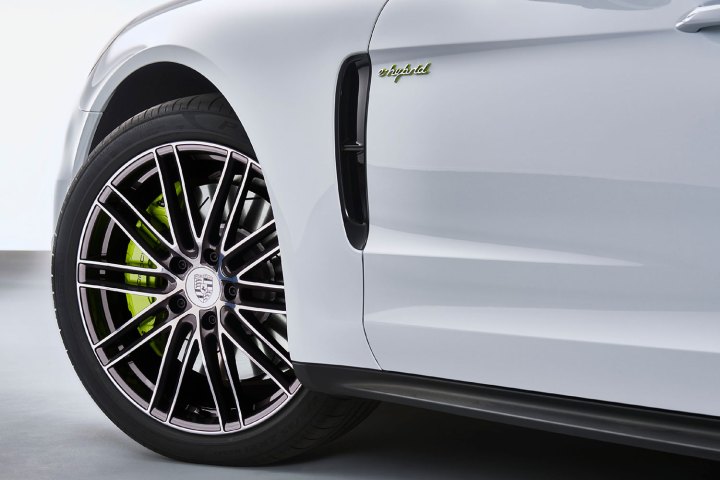
Porsche is re-inventing itself as a company.
After breaking into new segments and setting numerous sales records, the storied German brand is putting more focus on electrification than ever before. The 918 Spyder is sold out, but Porsche just launched a plug-in hybrid version of the new Panamera, and it’s set to introduce its first-ever electric car before the end of the decade.
Digital Trends chatted with Michael Steiner, a member of Porsche’s executive board who represents research and development, during the Paris Auto Show to gain insight on what the future holds.
Digital Trends: How have customers reacted to Porsche downsizing its portfolio of engines?
Michael Steiner: They like it very much. We have a lot of feedback on the 911 because the car is already on sale in many markets. The new downsized flat-six engines have been very well accepted. The 718 Boxster and 718 Cayman just went on sale so we don’t have a lot of feedback yet, but what we’ve heard so far is positive. We’re looking forward to hearing more about it. Performance-wise I think it’s outstanding.
What feedback have you received about hybridization and electrification?
It’s been good. We are convinced that hybridization and electrification boost performance. We underlined that with the 918, it’s clear that it delivers outstanding performance. Regarding series-produced cars, we want to become one of the companies that drives the shift towards hybrids and plug-in hybrids.
If other car-makers keep building pod-like driverless cars that all look the same I think it’s very good for Porsche!
We were the first in the luxury segment to have hybrids and plug-in hybrids – the Cayenne and the Panamera – but we felt that in terms of performance there was room for improvement. That’s one reason why we introduced new technology in the Panamera e-hybrid. We decided not to add more weight to the car, and customers asked us to ensure the battery pack doesn’t eat up trunk space. That said, we increased its all-electric range dramatically from somewhere around 30 kilometers to about 50.
Performance-wise we changed two things. First, the electric motor offers 100 kilowatts compared to 70 previously, which means it’s significantly more powerful. Second, we have four-wheel drive so the new Panamera hybrid is much more dynamic to drive regardless of which mode is engaged.
In the future we plan to use electrification to boost performance, while improving gas mileage. How much of an improvement we can achieve largely depends on each buyer’s driving style. The benefit is huge for those who drive downtown a lot and plug in at home every night. If you drive mostly on the highway you’ll see a performance boost, but fuel economy doesn’t improve drastically.
Not adding mass is impressive. Can we expect that weight will actually go down one day?
Maybe someday, if cell technology improves, we’ll be able to reduce both the size and the weight of the battery pack. However, I think that in the coming years new battery technology will primarily boost range and performance.
That said, I personally think we’ll reach a point where it won’t make sense to add more range and more power. There’s a tipping point in torque distribution where it’s better to have a full electric drivetrain, and it’s about when 50-percent of the power comes from electricity and 50-percent comes from gasoline. That’s where the Mission E comes in; we can have a car that’s fully electric but sporty, a real Porsche.

Volkswagen is making huge investments in electrification, but it’s not giving up on the internal combustion engine. Does the same apply to the Porsche brand?
We will stand at least on two legs. Our customers really enjoy high-revving gasoline engines, both turbocharged ones and naturally-aspirated ones. We’ll do everything we can to offer such engines as long as government regulations allow us to. We’ll develop and improve our flat-fours and flat-sixes for as long as possible.
Naturally-aspirated engines will continue to play a role in the Porsche lineup. You’ll find them in track-focused cars. Turbocharged engines, on the other hand, will power the models that enthusiasts buy to drive on a daily basis.
Where does Porsche stand on autonomous driving?
We have some assistance features for stop-and-go traffic on the Panamera. We’ll roll out more in the near future, but always for situations when it’s not fun to drive. Make no mistake, autonomous cars will never represent our brand. Porsche will always provide emotion and precision. And, if other car-makers keep building pod-like driverless cars that all look the same I think it’s very good for Porsche!
Editors' Recommendations
- Porsche’s second electric model is a sports car in hiking boots
- Lucid Air beta prototype shows 1,000-hp, 400-mile, electric car isn’t dead yet
- Porsche expands its hybrid range with three gasoline-electric Cayennes




